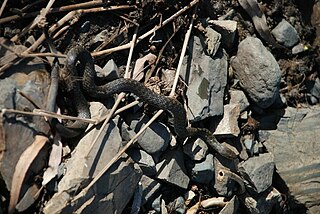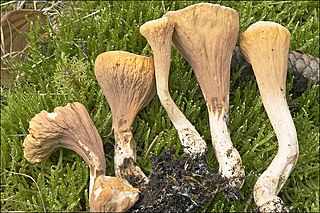
Bottlenose dolphins are aquatic mammals in the genus Tursiops. They are common, cosmopolitan members of the family Delphinidae, the family of oceanic dolphins. Molecular studies show the genus definitively contains three species: the common bottlenose dolphin, the Indo-Pacific bottlenose dolphin, and Tamanend's bottlenose dolphin. Others, like the Burrunan dolphin, may be alternately considered their own species or be subspecies of T. aduncus. Bottlenose dolphins inhabit warm and temperate seas worldwide, being found everywhere except for the Arctic and Antarctic Circle regions. Their name derives from the Latin tursio (dolphin) and truncatus for their characteristic truncated teeth.

The common keelback, also known as Mair's keelback, is a species of nonvenomous snake in the family Colubridae. The species is endemic to Australasia.

Clavariadelphus truncatus is a species of mushroom. The common name of the species is truncated club or club coral. It is a member of the basidiomycete fungi family Gomphaceae.
Tropidonophis doriae, commonly known as the barred keelback, is a species of snake belonging to the family Colubridae. The species is native to New Guinea and some nearby islands.

Tropidonophis is a genus of snakes in the subfamily Natricinae of the family Colubridae.
Tropidonophis montanus, the North Irian montane keelback, is a species of colubrid snake. It is found in New Guinea.
Tropidonophis aenigmaticus, the East Papuan keelback, is a species of colubrid snake. It is found on Fergusson Island in Papua New Guinea.
Tropidonophis dahlii, also known commonly as the New Britain keelback, is a species of snake in the family Colubridae. The species is native to Indonesia and Papua New Guinea.

Tropidonophis dendrophiops, the spotted water snake, is a species of colubrid snake. It is found in the Philippines.
Tropidonophis dolasii is a species of snake in the family Colubridae. The species is endemic to Papua New Guinea.
Tropidonophis elongatus, the Moluccan keelback, is a species of colubrid snake. It is found in Indonesia.
Tropidonophis halmahericus is a species of colubrid snake. It is found in Indonesia.
Tropidonophis hypomelas, the Bismarck keelback, is a species of colubrid snake. It is found in Papua New Guinea.
Tropidonophis mcdowelli, the Northern New Guinea keelback, is a species of colubrid snake. It is found in Indonesia and Papua New Guinea.
Tropidonophis multiscutellatus, the many-scaled keelback, is a species of colubrid snake. It is found in Papua New Guinea and Indonesia.
Tropidonophis negrosensis, the Negros spotted water snake , is a species of colubrid snake. It is found in the Philippines.
Tropidonophis novaeguineae, the New Guinea keelback, is a species of colubrid snake. It is found in New Guinea.
Tropidonophis parkeri, Parker's keelback or highland keelback, is a species of colubrid snake. It is found in Papua New Guinea.
Tropidonophis picturatus, the painted keelback, is a species of colubrid snake. It is found in Indonesia.
Tropidonophis punctiventris the Halmahera keelback, is a species of colubrid snake. It is found in Indonesia.




